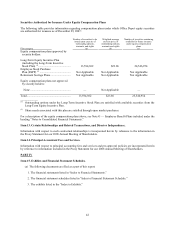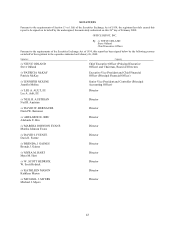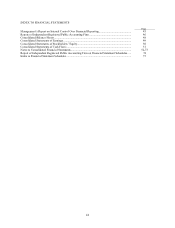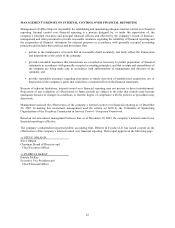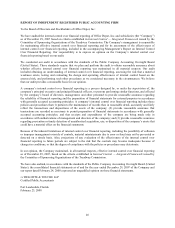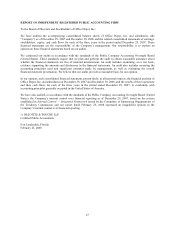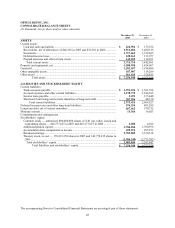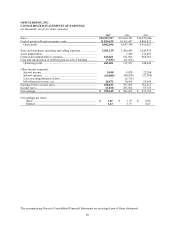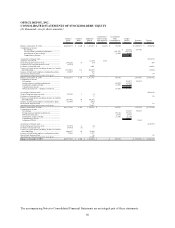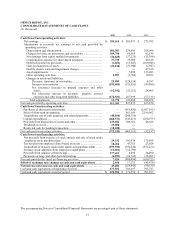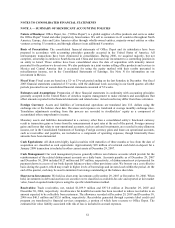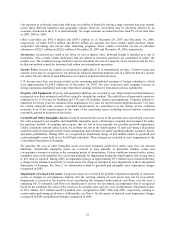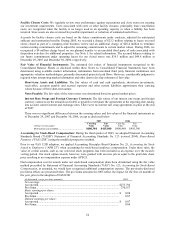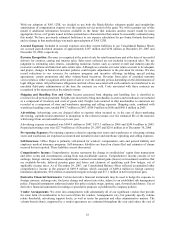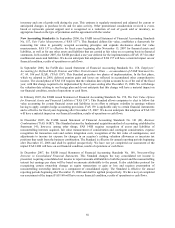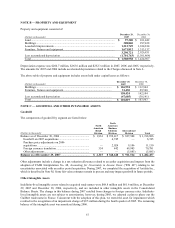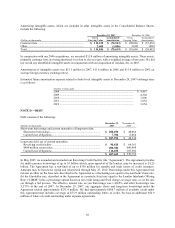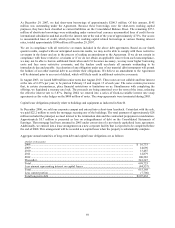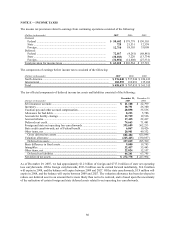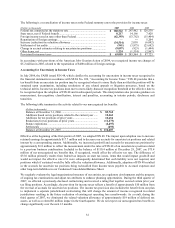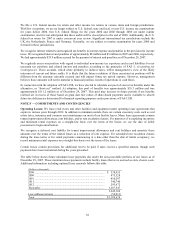Office Depot 2007 Annual Report Download - page 54
Download and view the complete annual report
Please find page 54 of the 2007 Office Depot annual report below. You can navigate through the pages in the report by either clicking on the pages listed below, or by using the keyword search tool below to find specific information within the annual report.52
NOTES TO CONSOLIDATED FINANCIAL STATEMENTS
NOTE A — SUMMARY OF SIGNIFICANT ACCOUNTING POLICIES
Nature of Business: Office Depot, Inc. (“Office Depot”) is a global supplier of office products and services under
the Office Depot® brand and other proprietary brand names. We sell to customers in 43 countries throughout North
America, Europe, Asia and Latin America either through wholly-owned entities, majority-owned entities or other
ventures covering 35 countries, and through alliances in an additional 8 countries.
Basis of Presentation: The consolidated financial statements of Office Depot and its subsidiaries have been
prepared in accordance with accounting principles generally accepted in the United States of America. All
intercompany transactions have been eliminated in consolidation. During 2006, we acquired majority, but not
complete, ownership in entities in South Korea and China and increased our investment to a controlling position in
an entity in Israel. Those entities have been consolidated since the date of acquisition with minority interest
presented for the portion we do not own. We also participate in a joint venture selling office products and services in
Mexico and Central America that is accounted for using the equity method with their results presented in
miscellaneous income, net in the Consolidated Statements of Earnings. See Note N for information on our
investment in Mexico.
Fiscal Year: Fiscal years are based on a 52- or 53-week period ending on the last Saturday in December. Our fiscal
2005 financial statements consisted of 53 weeks, with the additional week occurring in our fourth quarter; all other
periods presented in our consolidated financial statements consisted of 52 weeks.
Estimates and Assumptions: Preparation of these financial statements in conformity with accounting principles
generally accepted in the United States of America requires management to make estimates and assumptions that
affect amounts reported in the financial statements and related notes. Actual results may differ from those estimates.
Foreign Currency: Assets and liabilities of international operations are translated into U.S. dollars using the
exchange rate at the balance sheet date. Revenues and expenses are translated at average monthly exchange rates.
Translation adjustments resulting from this process are recorded in stockholders’ equity as a component of
accumulated other comprehensive income.
Monetary assets and liabilities denominated in a currency other than a consolidated entity’s functional currency
result in transaction gains or losses from the remeasurement at spot rates at the end of the period. Foreign currency
gains and losses that relate to non-operational accounts, such as cash and investments, are recorded in miscellaneous
income, net in the Consolidated Statements of Earnings. Foreign currency gains and losses on operational accounts,
such as receivables and payables, are included as a component of operating expenses, though historically these
amounts have been immaterial.
Cash Equivalents: All short-term highly liquid securities with maturities of three months or less from the date of
acquisition are classified as cash equivalents. Approximately $18 million of restricted cash held on deposit for a
January 2008 transaction is included in other current assets at December 29, 2007.
Cash Management: Our cash management process generally utilizes zero balance accounts which provide for the
reimbursement of the related disbursement accounts on a daily basis. Accounts payable as of December 29, 2007
and December 30, 2006 included $127 million and $97 million, respectively, of disbursements not yet presented for
payment drawn in excess of our book deposit balances where offset provisions exist. We borrow on a cost effective
basis during the quarter, which may result in higher levels of borrowings and invested cash within the period. At the
end of the quarter, cash may be used to minimize borrowings outstanding at the balance sheet date.
Short-term Investments: We held no short-term investments at December 29, 2007 or December 30, 2006. When
held, investments in debt and auction rate securities were classified as available-for-sale and reported at fair market
value, based on quoted market prices using the specific identification method.
Receivables: Trade receivables, net, totaled $1,039.9 million and $971.0 million at December 29, 2007 and
December 30, 2006, respectively. An allowance for doubtful accounts has been recorded to reduce receivables to an
amount expected to be collectible from customers. The allowance recorded at December 29, 2007 and December 30,
2006 was $46.3 million and $32.6 million, respectively. Receivables generated through a private label credit card
program are transferred to financial services companies, a portion of which have recourse to Office Depot. The
estimated fair value liability associated with risk of loss is included in accrued expenses.


